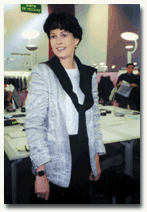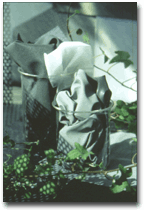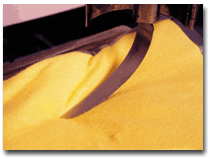ATI continues its coverage of technical innovations and refinements at ITMA
’99. Bruckner Trockentechnik GmbHandCo. KG presented an entirely new stenter generation
with split-flow air circulation system. The split-flow system gives a separate and precisely
adjustable supply of circulating air to the upper and lower nozzles by having two speed-controlled
fans in each half of any one compartment. This concept gives the user increased performance,
reduced energy consumption, gentle air impingement and homogeneous circulating air flow, according
to the company.Bruckner also introduced the Witro relaxation dryer. It features one fabric passage
and upstream stenter zone. The machine has a low-tension fabric transportation system and is
designed to process delicate or critical fabric styles.The Scout open-width washing and bleaching
range was also shown for the first time. It has high washing efficiency with low water, energy and
chemical consumption. It is designed to process delicate fabrics made of viscose, cupro, Lycra® or
lyocell.Datatex AG showed TIM (Textile Integrated Manufacturing) release 6.0, an ERP solution
specialized for the textile and apparel industries. New functions introduced with this release
include: order acceptance scheduling, year 2000 compliance, parallel accounting in euros and local
currency, and electronic business on the internet.At Datatex we have been working hard on all
fronts in the development of the new TIM functions demonstrated at ITMA, said Roberto Crovetto,
marketing manager. We are very happy with the results obtained, and we are sure to increase them in
the following months.Elbit Vision Systems Ltd. (EVS) exhibited its I-Tex 2000 fabric inspection
system and Loomtex, an automatic on-loom fabric inspection. The I-Tex 2000 is an automatic
inspection system designed to automate the fabric inspection process. The system can run at speeds
of up to 300 meters per minute, according to the company.The Loomtex system, which is currently in
final development and field test stage, brings the inspection process much closer to the weaving
process.Erhardt + Leimer GmbH demonstrated all of its automation solutions for the first time as an
integral part of a running machine line. Several completely new systems were shown. These new
systems were: the ELSIS automated fabric inspection system combined with the ELMARK default marking
system; the FE 80 digital wide band sensor; the ScanTech TMS 50 basis weight and thickness
measurement system; the ELMETA digital metal detector and the ELSMART digital segmented roller
guide system.The ELSIS automated fabric inspection system uses OptoLine HS, a camera inspection
system, to recognize contamination and holes in the fabric. The ELMARK marking system pinpoints
fabric faults and allows for quick fabric quality evaluation.The ELFEED digital controlled tenter
in-feed system was also popular with visitors to the Erhardt + Leimer stand. ELFEED has the
following features: digital sensors, pneumatic motorized edge spreaders, and patented trimmer and
web tension control system.Fiber Controls Corp. exhibited its Snowbreaker bale-opening machine with
single or double opening head design. The machine can process up to 4,000 pounds of material per
hour. This is a versatile design suitable for small to medium production runs. It can be used to
feed intimate blending lines by addition of weigh pans or feed cards directly by adding shaker
chutes. Snowbreaker was introduced last year, and there are now 100 units installed worldwide.Fongs
National Engineering Co. Ltd. displayed several new machines at ITMA 99 including the GN6-Super
high-temperature dyeing machine, the MK88 high-speed dyeing machine and the MK8C double-rope soft
dyeing machine.The GN6-Super high-temperature dyeing machine is designed for 100-percent cotton
fabrics with fast dyeing cycles with reactive dye. It incorporates a number of innovative features,
which enable it to shorten the entire dye cycle, according to the company.The MK88 high-speed
machine is designed for dyeing light or delicate woven fabric such as taffeta and satin.The MK8C
double-rope soft dyeing machine is designed for processing knit fabrics with a soft uniform hand.
It also has large fabric loading capacity.Groz-Beckert KG showed its patented KN 10
maintenance-free, high-performance steel and plastic composite needle. These needles are as
insusceptible to contamination as conventional full-shank needles, according to the company. In
addition, these needles have all the productive advantages and capacity of low-profile
meander-shape needles.James HoldsworthandBrothers Ltd. exhibited its complete line of flexible and
metallic card clothing as well as the 200 series cotton grinder, 200 series metallic cleaner, 200
series lightweight, flexible tension head and 200 series mounting equipment.The patented Sliver
Knitting Ring was the big attraction at the Holdsworth stand and is expected to increase company
sales by about 20 percent in the next three to four years. The Sliver Ring has had a tremendous
impact on plain and jacquard fur fabric production worldwide and has opened up extensive new
markets for the 209-year-old family firm.Mahlo GmbH + Co. KG showed a new generation of automatic
weft control and quality monitoring systems, the 10a series including the FMC-10a, the QMS-10a and
the CIS-10a. All of these are based on the well-known Orthomat family.Common features include
improved signal generation and analysis. All component parts are networkable. Scanner assemblies,
straighteners and PC communicate via Ethernet, reducing time and money spent in wiring on site. By
selecting the appropriate IP-address, the visual display can be routed to any PC on the client
companys network. Settings can be altered and recipes can be created in the same way.The new user
interface comprises a 15-inch TFT-display with touch screen. The size and location of the touch
pads are tailored to meet on-site requirements. Menu prompts enable operators to react
instinctively and audio responses are available to provide additional user assistance, according to
the company.Karl Mayer Textil-maschinenfabrik GmbH exhibited 18 machines at two stands in Paris.
Several new machines were introduced. The HKS 4 tricot machine was shown with a maximum speed of
1,500 rpm. The machine is designed to produce a wide range of products including automotive
textiles, sportswear and technical fabrics.The RS 2 (3) MSU raschel machine was shown with a width
of 213 inches. It has servomotor control for gentle processing of weft yarns. The machine produces
technical fabrics and has a top speed of 1,400 rpm.The RJWB 4/2 F-NE-Cliptronic® machine is
designed to make bodywear and ladies outerwear with relief-like pattern effects.A. Monforts
Texilmaschinen GmbH launched its new Montex 5000 stenter at ITMA. It offers improved ease-of-use
and drying performance that is up to 18 percent better than the previous model.The Monforts
Interknit Line for nonstop finishing of knit fabrics was also introduced at the Paris show. The
main advantages of this continuously operated finishing line are single operator control and
nonstop finishing possibilities.The companys Ecobleach® process for desizing and bleaching in one
application was shown at ITMA as a market study. In-depth field tests for this system are
planned.Morrison Textile Machinery showed its all-new MICRO-SAT bleach saturation system. MICRO-SAT
was designed to address the industrys need for devices to add into current installations for
automation and chemical savings. The system uses an operator-friendly digital PLC or PC controls
for mixing and dosing. Liquor is fed on a mass throughput, semi-continuous demand basis,
eliminating periodic titration.Morrison also unveiled its new RBM-SF, engineered for both
tolerance-critical compressive shrinking and high-speed hand enhancement. Productivity improvements
include a new entry that is more adjustable for fabric style changes, redesigned blanket pressure
and tension controls, and the visibly new change is its steel frame, configured to ensure the
shortest rubber blanket change time.Morrison displayed two sizes of the all-new M-washer.
Performance features include a dual-purpose serpentine counter-flow baffling with counter-current
wash-water flow coupled with fabric wiping action. An optional internal nip is available to further
increase wash efficiency.Although the total show attendance was flat, traffic at the Morrison stand
exceeded the 1995 ITMA, said John M. White Jr., company president. The industry seems focused on
finishing for value-added enhancements, flexibility and cost savings. More companies visited with
higher-level people.NoyVallesina Engineering SpA shared details about its PET polycondensation
plant. This simple design made of only three reactors allows NoyVallesina to own the cheapest PET
plants in terms of investment and throughput ratio and maintenance cost worldwide, according to the
company.In addition, the compactness of the design allows savings also on civil works and steel
structures. The 3-reactor polyester technology is a proven technology that can produce up to 480
tons per day with direct spinning lines for staple and continuous filament for fiber grade
applications and up to 600 tons per day for bottle grade applications.Schaetti AG showed for the
first time a double-dot suction device to make a double dot with a paste base and scatter coated
nylon powder on fabrics. This is mainly for very light garment interlinings with weft insert and
nonwoven interlinings. The company also showed a scatter-coating head for an automatic
powder-feeding system and a powder distribution device for the scatter-coating head. The double-dot
suction device drew the most attention at the Schaetti stand.Schaetti has also announced a
partnership between itself and Bostik Ltd. Schaetti will now market Bostiks fusible powders
worldwide excluding America. Bostik Europe had been Schaettis sole supplier for polymers. Visitors
to the Schaetti stand at ITMA were very positive about this development. Schaetti also said that it
had some problems with the infrastructure of the Paris exhibition. The company found the
loudspeaker announcements and the strikes during the show particularly annoying.Sclavos
International exhibited its Venus dyeing machine with AquaChron in two new versions: Smart and XI.
Venus is equipped with the companys Twin Soft Flow dyeing system. It is a two nozzle high-flow
low-pressure (0.18 bars) that is said to overcome the fundamental drawback of conventional jet
dyeing systems.The Venus with AquaChron Smart can, without human interference, monitor, control and
interact with all process parameters such as liquor ratio, process times, water and steam supplies,
speed and revolution, according to the company.TEMCO Textilmaschinen-komponenten GmbHandCo. KG
showed several innovations for man-made fiber manufacturing including: the covering spindle PCS
(power controlled spindle), WIN-OLT Process monitoring system, and several new tangling jet
designs.The new covering spindle PCS (power controlled spindle) is single-motor driven and
position-related controlled. In the foreseeable future the company expects this new concept will
have a similarly successful breakthrough like the single-motor drive in the case of the MSE
covering spindle.The WIN-OLT process monitoring system was also shown for the first time. This
system enables machine operators to detect in a simple and easy way irregularities in the
production process, and to intervene accordingly, taking any necessary corrective steps. The
WIN-OLT system is based on the Windows user interface.In the field of tangling jets, TEMCO
presented several innovative products at ITMA 99 for the first time including: new ceramic inserts
with Y-orifice for LD 22 Y, anti-torque jet type LD 6 for anti-snarling effect on texturing
machines and new CI-jet in open/close system for continuous interlacing yarns.Otto Zollinger Inc.
showed its complete line of yarn tension control devices for 80 textile application areas. The
company had three new innovations to show visitors: the OZ Quickset, the OZ 2000 T and the 0Z
Transfer Tail Holder. The company has patents on all three.The OZ Quickset allows users to quickly
and easily dial in up to five tension settings without re-threading the yarn. The OZ 2000 T is
designed for carpet warping and tufting creels. The unit is said to increase tufting production
from 10 to 35 percent. Each percentage point can be worth up to $50,000 per year to the carpet
maker, according to Zollinger. The 0Z Transfer Tail Holder securely holds the yarn transfer tail
out of the way, preventing tangles and ensuring a clean transfer between packages.Our system works
on any yarn regardless of size, twist, fiber type or color, said Otto Zollinger, company president.
We improve quality and productivity by controlling yarn tension.
December 1999







